U.S. Route 101, South of San Juan Bautista, California, July 2011
California's Mission San Juan Bautista was founded by Spanish fathers as the fifteenth of twenty-one Roman Catholic missions in 1797. Named for St. John the Baptist, the mission represents redemption through the cleansing of sin, and acceptance of Jesus Christ as one's savior.
Mission San Juan Bautista, San Juan Bautista, California, July 2011
But for the avid moviegoer, the mission is immortalized as the place where a torn Kim Novak and an obsessive James Stewart brought themselves to a point well beyond redemption in Alfred Hitchcock's masterpiece, Vertigo, filmed here in 1957, and released the next year.
The mission has changed little since Hitchcock and Robert Burks, director of photography, filmed Vertigo more than 50 years ago, with one exception: The tower where the movie's climatic scene takes place was a figment of set designer Henry Bumstead's imagination, and inserted into the film by way of matte painting.
San Juan Bautista's fictitious tower, Henry Bumstead, designer, 1958
Image copyright 1958, Universal Studios
The mission church as it exists in reality, with a smaller, external bell tower to right;
The missions original bell tower was destroyed in a fire in the 1800s
Photo taken July 2011
I was able to capture these images with the amazing Hasselblad Xpan camera, which captures its images on a focal plane 65mm wide by 24 mm high, the exact same in-camera dimensions as Paramount's VistaVision camera, on which Vertigo was shot in Technicolor. The second of these photographs was taken on Kodak's Vericolor III film, which has not been available since the 1990s. But the rest were photographed on CVS drugstore 200 ASA color film, which is really rebranded Fuji Superia. It is amazing how the drugstore film of today has truer colors and better accutance than the pro film of yesteryear.
Detail of Plaza Livery Stable, July 2011
Standing outside the mission, I can hear Bernard Herrmann's mesmerizing soundtrack in my mind.
Dissolve of Livery Stable and Courtyard, July 2011
Courtyard, Plaza Hall, and Livery Stable, as seen from Convent arch, July 2011
Plaza Hotel, July 2011
Mission San Juan Bautista and courtyard, July 2011
In addition to the mission at San Juan Bautista is the lovely small town of the same name, where you can dine in very civilized fashion at Joan and Peter's German Restaurant, which makes one of the best Sauerbratens I've had in the United States, and a Westfalischen Schnitzel the California way, with melted Monterrey Jack cheese.













































